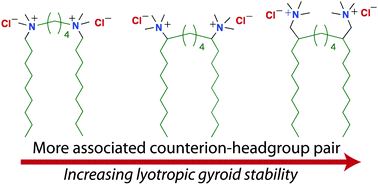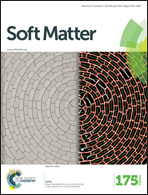Unexpected role of linker position on ammonium gemini surfactant lyotropic gyroid phase stability†
Abstract
Arising from the water-driven self-assembly of amphiphiles over generally narrow temperature and composition phase windows, aqueous lyotropic liquid crystal (LLC) network phases are useful in applications as therapeutic delivery vehicles and templates for mesoporous material syntheses. While a clear set of amphiphile design rules that enables access to these intricate three-dimensional structures has yet to emerge, recent work indicates that bis(ammonium), bis(phosphonium), and dicarboxylate gemini (“twin tail”) surfactants enable enhanced access to LLC network phases such as the double gyroid (G). In order to better understand the scope of this amphiphile design strategy, we investigated the synthesis and aqueous LLC self-assembly behaviors of a homologous series of quaternary gemini bis(ammonium) dichloride surfactants, in which we varied the position of the hydrophobic linker that connects the constituent single tail surfactants. These experiments demonstrate that the position of the linker directly impacts the maximum counterion–headgroup hydration capacity and the extent of counterion–headgroup association, all of which contribute to the aqueous lyotropic double gyroid network phase stability. Thus, judicious selection of the linker position in ionic gemini surfactants provides a new molecular design tool for manipulating LLC network phase stability.


 Please wait while we load your content...
Please wait while we load your content...